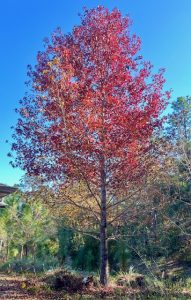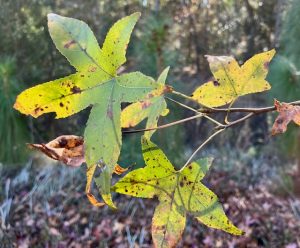In the Christmas story as recorded in the book of Matthew, wise men presented gifts to baby Jesus. Two of these gifts were frankincense and myrrh. These are costly perfume oils derived from certain trees found in parts of the Middle East.
According to Dr. Kim Coder, urban forestry specialist with the UGA Extension Service, there are more than 36 trees mentioned throughout the Old and New Testaments. Some of these trees have relatives living here in Florida.
In an article on this topic, Coder said, “The trees most people think of from the Bible are the Cedars of Lebanon.” Lebanon cedars are true cedars like the Deodar cedar found planted in some North Florida communities. He said, “Today a relict (species of an earlier time) grove of 400 trees still survives on Mount Lebanon that is more than 2000 years old.”
The sycamore common to North Florida does not grow in Palestine. “The sycamore of the Bible is the sycamore fig,” Coder explained. The fruit of the sycamore fig is smaller and less sweet as compared to the table fig and was considered food for the poor. Another name used by some people in the United States for sycamore is plane tree but Coder said that the plane trees referred to in the Bible were the flowering viburnums and oriental plane trees in the Middle East. “Also mentioned is the sycamine, which is the black mulberry,” Coder said.
The poplar trees of the Bible are the same white poplar that you can find growing in some areas of North Florida but it is more commonly found north of Florida. “But poplar also means
snowbell, which is related to our native snowbells,” Coder said. “The name poplar was used for two distinctly different trees.”
One tree from the Bible that is common in North Florida is balm. “The balm, or balm of Gilead, was the sweetgum tree,” Coder said. The sweetgum of the Middle East is almost identical to our sweetgum tree that grows all over North Florida. Coder said that there is a tree named “Balm of Gilead” that grows in the northern United States but it is native only to North America. “Our sweetgum is a botanical link to the sweetgum of the Bible,” he said.
Ebony wood, which is also mentioned in the Bible, was imported for carvings and decorations. “Ebony is related to our common persimmon,” Coder said.
Florida’s forests are filled with close relatives of a number of Biblical trees. “There are many links to our cultural heritage stemming from the Bible,” Coder said. “Touch a sweetgum leaf and you hold a piece of Christian and Jewish history.”
- Evaluate and Renovate Landscape During Fall - October 30, 2025
- Summer is Too Hot for Lawn Herbicides - August 23, 2025
- Nuisance Gnats abound in Northwest Florida this spring - June 26, 2025


